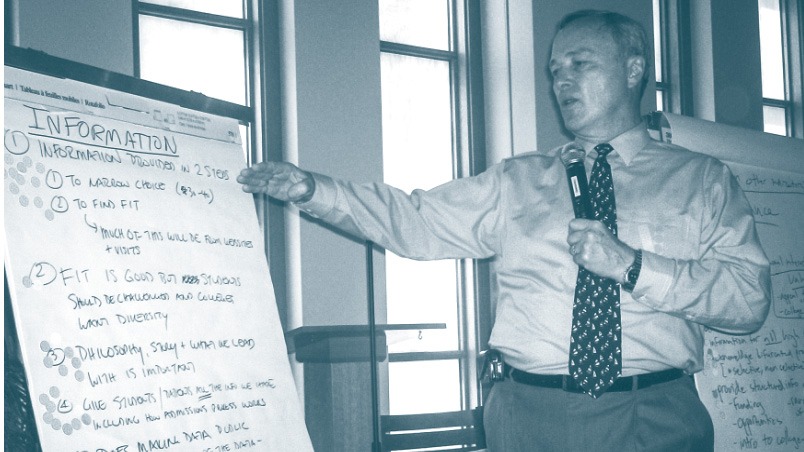Hire Education
Carving out a decent career doesn’t require spending four years and a king’s ransom in pursuit of a bachelor’s degree
Career training has expanded so much lately that it’s creating alternatives to expensive four-year college degrees.
Fifty years ago, vocational-technical education primed high school students for jobs like meat cutting or auto mechanics—almost anything that took some skill but didn’t require a college degree. Students took practical classes like home economics or shop. They spent part of the school day on the job, getting real-world work experience at local businesses.
But now, career-oriented schooling has grown into something nearly unimaginable half a century ago. Today, it’s called career and technical education, or CTE, and it introduces middle school students to the world of work, teaches high schoolers how abstract academics apply to real jobs, helps college students understand where their majors may take them in life, and refurbishes older workers for new careers.
“They’ve moved away from using the word ‘vocational’ because there’s a lot of baggage associated with it,” said Steve Klein, center director at Education Northeast, a nonprofit that provides schools with research, evaluation and technical assistance. “In the past, it typically was a place where you put kids who didn’t function in a traditional academic, ‘sit and get’ kind of classroom.”
CTE continues the vo-tech tradition of helping to prepare young people for honorable and often well-paid manual work as plumbers or electricians, while also becoming broad enough to give students a taste of what might lie ahead for them in prestigious fields like engineering and healthcare.
“More and more educators view CTE as this huge umbrella,” noted James Greenan, chair and professor of CTE at Purdue University. “CTE encompasses all careers.”
Besides prepping a student for a job, firsthand experience in the workplace can also have a fortuitous side effect, Klein said. It can show high school or college students that they’re not cut out for a particular line of work.
“Learning what you don’t want is better than learning what you do because it saves you a lifetime of misery,” he maintained. In one unfortunate example, his old roommate didn’t admit to himself that he really had no interest in legal technicalities until after he’d wasted two years in law school and run up $80,000 in debt.
At first glance, CTE can seem like a patchwork of uncoordinated classes and training sessions offered by schools of every description—not to mention the apprenticeships operated by trade unions.
But some schools are working to introduce coherence.
Once students settle on their career path, Utah State University Eastern provides a clear, logical avenue toward higher levels of study in job-oriented fields, said Gary Straquadine, the institution’s associate vice president for CTE. It’s an unusually well-planned “stackable” approach with one program building upon another.
In other words, students can pursue CTE study in any of about 30 areas that lead to a certificate in a year or less, an associate’s degree after two years or a bachelor’s degree after four years. They can finish a course of study, work for a few years, and then return to pursue the next step, Straquadine noted. To help students get started in life, the school somehow manages to charge lower tuition for certificate courses.
“We’ve flipped higher ed on its ear,” Straquadine said of the CTE curriculum. The school has tossed aside the usual pattern of taking general courses in the first two years of college and specialized courses in the latter two years. Instead, students in the USU Eastern system concentrate on the job-oriented learning first, and the theory behind it comes later.
In one example, students earn a certificate by spending two semesters focused narrowly on the skills needed to work as a CNC (computer numerical control) machinist. If they pursue an associate’s or bachelor’s degree, they learn the math, physics and chemistry underlying CNC machining.
In the CNC machining major, a third of USU Eastern students don’t go beyond a certificate, but a third eventually go farther academically. The other third get “lost” when they change careers or otherwise drop out of sight of the school’s data keepers.
Businesses are taking note of the USU Eastern CTE programs. They’re coming to realize, for example, they can meet their needs by hiring a cybersecurity worker with an associate’s degree for $45,000 a year, instead of one with a bachelor’s for $80,000, Straquadine said.
CTE as a major
Meanwhile, CTE has become a field of study onto itself, and students can pursue a bachelor’s, master’s or doctorate. The courses don’t focus on technical subjects but instead concentrate on professional and administrative skills. CTE majors, who range from pilots to psychologists, tend to bring their own tech skills with them, Purdue’s Greenan said.
Whatever their background, CTE majors find plenty of opportunities to help young people, he noted.
After all, CTE reduces the number of students who drop out after a couple of years of college with nothing to show for it but $22,000 of debt, Straquadine said. That’s why he refers to CTE as “hire education, not higher education.”
Still, CTE’s not perfect. Introducing it too early and too stridently can stifle students. In Western Europe, which is becoming notorious for stunting kids through early placement, tests can steer a 13-year-old into a life as a baker, Straquadine noted. Plus, schools can go too far in allowing businesspeople on CTE advisory boards to dictate academic policy, he acknowledges.
Yet, CTE offers hope. “It can be a strategy to help all students gain a better sense of what it means to work and what skills they would need to be successful,” said Northwest Education’s Klein. “To a question of what percentage of students would benefit from CTE, my response to that would be all of them.”
CTE: Venerable and All-encompassing
It’s fair to say today’s career and technical education, or CTE, evolved from fairly recent vocational-technical classes.
But its roots reach deeper: The original mission of land grant universities was to teach mechanics and agriculture. Those schools began appearing on the American scene as early as the 1860s.
Plus, one can argue that every class taught anywhere at any time qualifies as a vocational class. That’s because most people eventually have to get a job.
A 5-star Career
The University of Utah Eastern, an institution that works hard to put students on career paths, rates occupations by assigning them stars for high wages and high demand.
The field of diesel mechanics, for example, rates five stars. Cosmetology earns three stars in general, but wages rise significantly with specialization in lashes and nails.
Familiarity with the rewards of specific jobs is an important part of high school and college career and technology training, or CTE. It’s the successor to the vocational-technical training that began in secondary schools.
UTU Eastern offers career paths in 30 areas that fall into three categories: business, healthcare and general. Jobs in the latter group are usually associated with coveralls and safety glasses.
Who Controls CTE?
Politicians of almost every stripe can agree on at least one issue: They concur that government should help underwrite the cost of career and technical education, or CTE.
Nearly $1.3 billion in annual federal CTE funding flows to the 50 states, accompanied by a few requirements and standards that give Congress some say in how it’s administered, said Kate Kreamer, deputy executive director of the Advance CTE, an association of state CTE directors.
But most of the power to administer CTE resides with the states, colleges and local governments. That means CTE initiatives and opportunities vary considerably, Kreamer noted.











